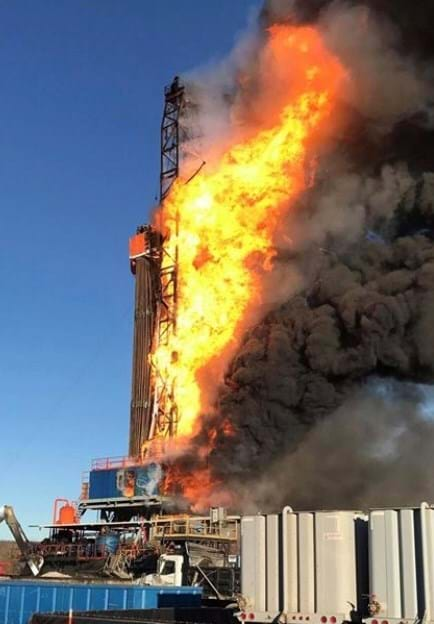
THE US Chemical Safety Board (CSB) has urged regulators to develop safety standards for onshore oil and gas drillers, and address shortcomings in alarm management after a blowout killed five workers last year.
The fatal fire is the deadliest drilling incident since the Deepwater Horizon blowout killed 11 people in 2010. The fire occurred at a drilling operation in Oklahoma in January last year after two crucial safety barriers failed. Hydrostatic pressure in the Pryor Trust well was not maintained, allowing gas to escape, and this escaping gas was not detected by operators due in part because they had turned off the entire alarm system. In short, the CSB says its investigation found that lack of planning, training, equipment, skills and procedures contributed to the failure.
CSB Interim Executive Kristen Kulinowski said: “Our investigation found significant lapses in good safety practices at this site. For over 14 hours, there was a dangerous condition building at this well. The lack of effective safety management at this well resulted in a needless catastrophe.”
Onshore oil and gas drillers are not required to implement the Occupational Safety and Health Administration’s (OSHA’s) Process Safety Management standard used to govern safety at chemical processing facilities. The CSB is urging OSHA to either require drillers to use the standard or develop new rules specific to the challenges the industry faces.
Furthermore, the operating company Red Mountain Energy did not specify the barriers required during operations, or how to respond if a barrier was lost.
Kulinowski said: “As onshore oil and gas extraction grows, it is imperative that the industry is using proven and reliable safety standards and practices. If some of these safety practices had been in place, this tragedy could have been averted.”
Undetected escape
Workers failed to grasp that gas was escaping. A lack of training contributed, as one worker was unsure how to use new software to calculate how much mud needed adding to the well to compensate for the drill pipe being removed, and so failed to note a discrepancy that indicated gas escaping up the well.
On top of this, the alarm system that should have alerted staff that dangerous gas was entering the well had been entirely disabled. The CSB thinks this might have been turned off because the system had been set up to produce too many nuisance alarms related to non-hazardous conditions.
The CSB said warnings about ineffective alarm management have not been heard, pointing to the investigation into BP’s infamous Deepwater Horizonblowout. The National Commission’s Report to the President noted: “In the future, the instrumentation and displays used for well control monitoring must be improved. There is no apparent reason why more sophisticated, automated alarms and algorithms cannot be built into the display system to alert the driller and mudlogger when anomalies arise”.
To understand the scale of the problem with nuisance alarms, the CSB points to results presented at a meeting of the Society of Petroleum Engineers in 2017 that found that a typical offshore rig can generate as many as 50,000 alarms in a seven-day period. This far exceeds the 1 alarm per minute rate that is deemed unacceptable by the Norwegian Petroleum Directorate.
CSB Investigator Lauren Grim said: “With the alarm system off, the safety of the operation solely relied on workers to either visually identify signs of the gas influx or calculate volume differences that could indicate gas influx—and in this case, neither method was effective, and workers were unaware of the very large gas influx into the well before the incident. As a result, the workers had little knowledge of the impending disaster.”
The CSB has recommended that the API create guidance on alarm management for the drilling industry based on guidance in ANSI/ISA 18.2 Management of Alarm Systems for the Process Industries. It says the guidance should address the “unique dynamic environment of the drilling industry and provide guidance on implementing a state-based alarm system for different [drilling] operating modes”.
Furthermore, it says safety-instrumented systems used to bring wells to a safe state when other barriers fail are not used by drillers. It notes while “the drilling industry differs from the more steady-state process industry, the development of automatic well control systems appears to be an area that is technologically achievable, and there is a key opportunity for the drilling industry to research and develop such technology through the collaboration of drilling, engineering, and instrumentation experts.”
Make staff safe
The five workers who died were trapped in the driller’s cabin which overlooked the drilling pipe and well. When it caught fire they were unable to escape, and were overcome by heat and smoke. It says the American Petroleum Institute should develop guidance on cabin designs that protect workers from blowout conditions; consider evacuation methods such as chutes used in Ukraine to allow workers to quickly slide out of the cabin to safety; and consider moving cabins to remote locations with drillers using cameras to watch over the well from a safe distance.

The API has said it will review the report’s findings and consider its recommendations.
To read the CSB’s full report including its recommendations for regulators, the companies involved, industry groups, and the state of Oklahoma visit: https://www.csb.gov/file.aspx?DocumentId=6110
Source – https://www.thechemicalengineer.com/news/csb-calls-for-new-onshore-drilling-rules-after-blowout-kills-five/

